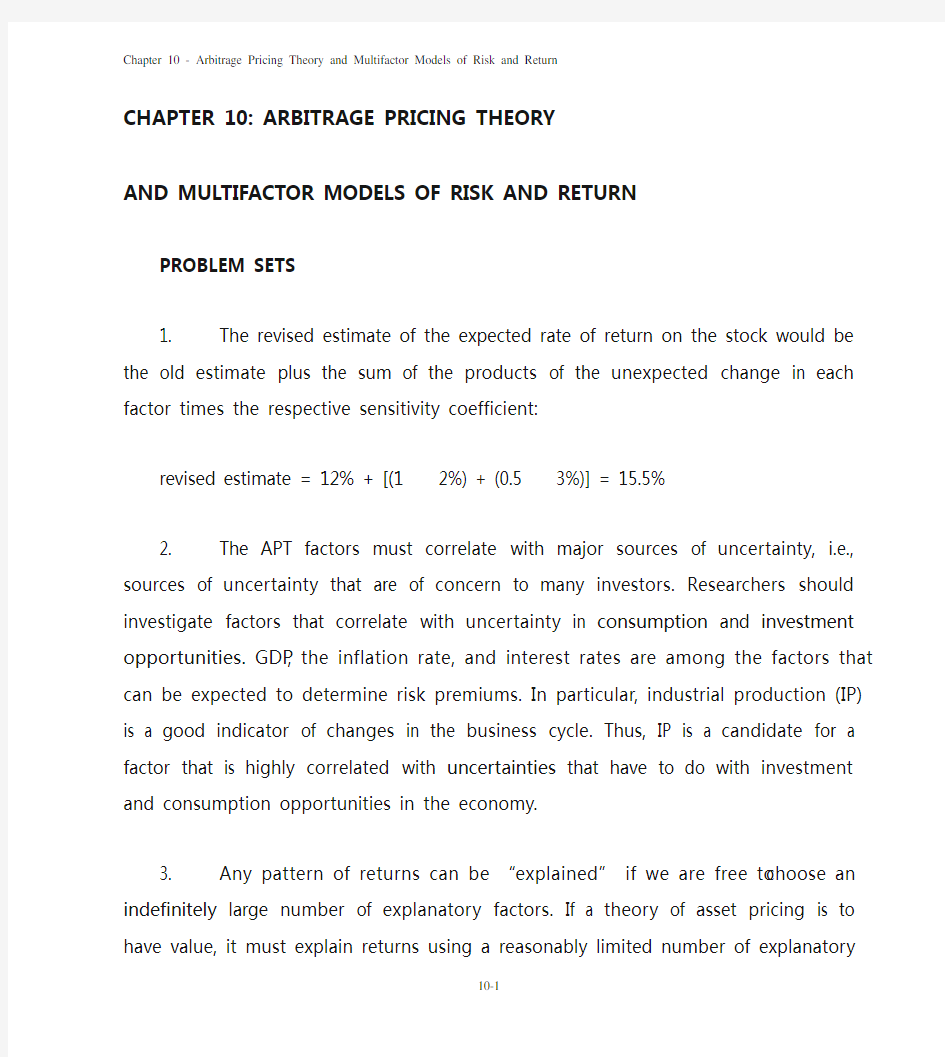
博迪第八版投资学第十章课后习题答案
- 格式:doc
- 大小:71.50 KB
- 文档页数:8


CHAPTER 10: ARBITRAGE PRICING THEORY
AND MULTIFACTOR MODELS OF RISK AND RETURN PROBLEM SETS
1. The revised estimate of the expected rate of return on the stock would be the old
estimate plus the sum of the products of the unexpected change in each factor times the respective sensitivity coefficient:
revised estimate = 12% + [(1 ⨯ 2%) + (0.5 ⨯ 3%)] = 15.5%
2. The APT factors must correlate with major sources of uncertainty, i.e., sources of
uncertainty that are of concern to many investors. Researchers should investigate factors that correlate with uncertainty in consumption and investment opportunities. GDP, the inflation rate, and interest rates are among the factors that can be expected to determine risk premiums. In particular, industrial production (IP) is a good indicator of changes in the business cycle. Thus, IP is a candidate for a factor that is highly correlated with
uncertainties that have to do with investment and consumption opportunities in the
economy.
3. Any pattern of returns can be “explained” if we are free to choose an indefinitely large
number of explanatory factors. If a theory of asset pricing is to have value, it must
explain returns using a reasonably limited number of explanatory variables (i.e.,
systematic factors).
4. Equation 10.9 applies here:
E(r p) = r f + βP1 [E(r1 ) - r f ] + βP2 [E(r2) – r f ]
We need to find the risk premium (RP) for each of the two factors:
RP1 = [E(r1) - r f ] and RP2 = [E(r2) - r f ]
In order to do so, we solve the following system of two equations with two unknowns:
31 = 6 + (1.5 ⨯ RP1) + (2.0 ⨯ RP2)
27 = 6 + (2.2 ⨯ RP1) + [(–0.2) ⨯ RP2]
The solution to this set of equations is:
RP1 = 10% and RP2 = 5%
Thus, the expected return-beta relationship is:
E(r P) = 6% + (βP1⨯ 10%) + (βP2⨯ 5%)
5. The expected return for Portfolio F equals the risk-free rate since its beta equals 0.
For Portfolio A, the ratio of risk premium to beta is: (12 - 6)/1.2 = 5
For Portfolio E, the ratio is lower at: (8 – 6)/0.6 = 3.33
This implies that an arbitrage opportunity exists. For instance, you can create a Portfolio
G with beta equal to 0.6 (the same a s E’s) by combining Portfolio A and Portfolio F in
equal weights. The expected return and beta for Portfolio G are then:
E(r G ) = (0.5 ⨯ 12%) + (0.5 ⨯ 6%) = 9%
βG = (0.5 ⨯ 1.2) + (0.5 ⨯ 0) = 0.6
Comparing Portfolio G to Portfolio E, G has the same beta and higher return. Therefore, an arbitrage opportunity exists by buying Portfolio G and selling an equal amount of
Portfolio E. The profit for this arbitrage will be:
r G– r E =[9% + (0.6 ⨯ F)] - [8% + (0.6 ⨯ F)] = 1%
That is, 1% of the funds (long or short) in each portfolio.
6. Substituting the portfolio returns and betas in the expected return-beta relationship, we
obtain two equations with two unknowns, the risk-free rate (r f ) and the factor risk
premium (RP):
12 = r f + (1.2 ⨯ RP)
9 = r f + (0.8 ⨯ RP)
Solving these equations, we obtain:
r f = 3% and RP = 7.5%
7. a. Shorting an equally-weighted portfolio of the ten negative-alpha stocks and
investing the proceeds in an equally-weighted portfolio of the ten positive-alpha
stocks eliminates the market exposure and creates a zero-investment portfolio.
Denoting the systematic market factor as R M , the expected dollar return is (noting
that the expectation of non-systematic risk, e, is zero):
$1,000,000 ⨯ [0.02 + (1.0 ⨯ R M )] - $1,000,000 ⨯ [(–0.02) + (1.0 ⨯ R M )]
= $1,000,000 ⨯ 0.04 = $40,000
The sensitivity of the payoff of this portfolio to the market factor is zero because
the exposures of the positive alpha and negative alpha stocks cancel out. (Notice
that the terms involving R M sum to zero.) Thus, the systematic component of total
risk is also zero. The variance of the analyst’s profit is not zero, however, since this
portfolio is not well diversified.